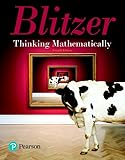Thinking Mathematically / Robert Blitzer
Material type: TextPublication details: Boston, USA Pearson Education, Inc. 2019Edition: 7th EdDescription: xxiii, 945p. : ill. ; AA1-AA63; I1-I16; C1-C3; 28cmISBN:
TextPublication details: Boston, USA Pearson Education, Inc. 2019Edition: 7th EdDescription: xxiii, 945p. : ill. ; AA1-AA63; I1-I16; C1-C3; 28cmISBN: - 9780134683713
- 9780134705095
- 9780134708300
- 23rd 510 BLI
| Item type | Current library | Collection | Call number | Status | Notes | Date due | Barcode | |
|---|---|---|---|---|---|---|---|---|
| Reference Book | VIT-AP General Stacks | Reference | 510 BLI (Browse shelf(Opens below)) | Not For Loan (Restricted Access) | MATH | 019484 |
It includes index and answers
MyLab Math Standalone Access Card to accompany Blitzer, Thinking Mathematically, 7/e
This item is an access card for MyLab(TM) Math. This physical access card includes an access code for your MyLab Math course. In order to access the online course you will also need a CourseID, provided by your instructor.
This title-specific access card provides access to the Blitzer, Thinking Mathematically, 7/e accompanying MyLab course ONLY.
0134705092 / 9780134705095 MyLab Math with Pearson eText - Access Card - for Thinking Mathematically, 7/e
MyLab Math is the world's leading online tutorial, and assessment program designed to help you learn and succeed in your mathematics course. MyLab Math online courses are created to accompany one of Pearson's best-selling math textbooks. Every MyLab Math course includes a complete, interactive eText.
For courses in Liberal Arts Mathematics.
Show students their world is profoundly mathematical, meaningful, and fun
Students often struggle to find the relevance of math in their everyday lives. In Thinking Mathematically, 7th Edition, Bob Blitzer’s distinctive and relatable voice engages students in the world of math through compelling, real-world applications — student-loan debt, time breakdown for an average NFL broadcast, and many more.
Understanding that most students in this course are not math majors (and are unlikely to take another math class), Blitzer uses current data compiled from hundreds of books, magazines, and online sources to show students how truly meaningful and fun math can be.
Also available with MyLab Math
MyLab™ Math is the teaching and learning platform that empowers you to reach every student. By combining trusted author content with digital tools and a flexible platform, MyLab personalizes the learning experience and improves results for each student. Learn more about MyLab Math.
Table of Contents
(NOTE: Each chapter concludes with a Chapter Summary, Review, and Test, and a comprehensive Chapter Test.)
1. Problem Solving and Critical Thinking
1.1 Inductive and Deductive Reasoning
1.2 Estimation, Graphs, and Mathematical Models
1.3 Problem Solving
2. Set Theory
2.1 Basic Set Concepts
2.2 Subsets
2.3 Venn Diagrams and Set Operations
2.4 Set Operations and Venn Diagrams with Three Sets
2.5 Survey Problems
3. Logic
3.1 Statements, Negations, and Quantified Statements
3.2 Compound Statements and Connectives
3.3 Truth Tables for Negation, Conjunction, and Disjunction
3.4 Truth Tables for the Conditional and the Biconditional
3.5 Equivalent Statements and Variations of Conditional Statements
3.6 Negations of Conditional Statements and De Morgan’s Laws
3.7 Arguments and Truth Tables
3.8 Arguments and Euler Diagrams
4. Number Representation and Calculation
4.1 Our Hindu-Arabic System and Early Positional Systems
4.2 Number Bases in Positional Systems
4.3 Computation in Positional Systems
4.4 Looking Back at Early Numeration Systems
5. Number Theory and the Real Number System
5.1 Number Theory: Prime and Composite Numbers
5.2 The Integers; Order of Operations
5.3 The Rational Numbers
5.4 The Irrational Numbers
5.5 Real Numbers and Their Properties; Clock Addition
5.6 Exponents and Scientific Notation
5.7 Arithmetic and Geometric Sequences
6. Algebra: Equations and Inequalities
6.1 Algebraic Expressions and Formulas
6.2 Linear Equations in One Variable and Proportions
6.3 Applications of Linear Equations
6.4 Linear Inequalities in One Variable
6.5 Quadratic Equations
7. Algebra: Graphs, Functions, and Linear Systems
7.1 Graphing and Functions
7.2 Linear Functions and Their Graphs
7.3 Systems of Linear Equations in Two Variables
7.4 Linear Inequalities in Two Variables
7.5 Linear Programming
7.6 Modeling Data: Exponential, Logarithmic, and Quadratic Functions
8. Personal Finance
8.1 Percent, Sales Tax, and Discounts
8.2 Income Tax
8.3 Simple Interest
8.4 Compound Interest
8.5 Annuities, Methods of Saving, and Investments
8.6 Cars
8.7 The Cost of Home Ownership
8.8 Credit Cards
9. Measurement
9.1 Measuring Length; The Metric System
9.2 Measuring Area and Volume
9.3 Measuring Weight and Temperature
10. Geometry
10.1 Points, Lines, Planes, and Angles
10.2 Triangles
10.3 Polygons, Perimeter, and Tessellations
10.4 Area and Circumference
10.5 Volume and Surface Area
10.6 Right Triangle Trigonometry
10.7 Beyond Euclidean Geometry
11. Counting Methods and Probability Theory
11.1 The Fundamental Counting Principle
11.2 Permutations
11.3 Combinations
11.4 Fundamentals of Probability
11.5 Probability with the Fundamental Counting Principle, Permutations, and Combinations
11.6 Events Involving Not and Or; Odds
11.7 Events Involving And; Conditional Probability
11.8 Expected Value
12. Statistics
12.1 Sampling, Frequency Distributions, and Graphs
12.2 Measures of Central Tendency
12.3 Measures of Dispersion
12.4 The Normal Distribution
12.5 Problem Solving with the Normal Distribution
12.6 Scatter Plots, Correlation, and Regression Lines
13. Voting and Apportionment
13.1 Voting Methods
13.2 Flaws of Voting Methods
13.3 Apportionment Methods
13.4 Flaws of Apportionment Methods
14. Graph Theory
14.1 Graphs, Paths, and Circuits
14.2 Euler Paths and Euler Circuits
14.3 Hamilton Paths and Hamilton Circuits
14.4 Trees
Answers to Selected Exercises
Credits
Subject Index
There are no comments on this title.

